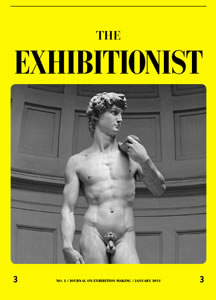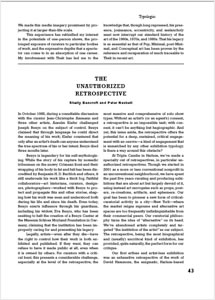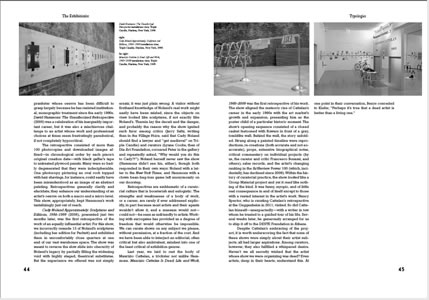"The Unauthorized Retrospective," in The Exhibitionist: Journal on Exhibition Making, No. 3 (January 2011), pp. 43-5.
By Shelly Bancroft and Peter Nesbett
In October 1985, during a roundtable discussion with the curator Jean-Christophe Ammann and three other artists, Anselm Kiefer challenged Joseph Beuys on the subject of control. Beuys claimed that through language he could direct the meaning of his work; Kiefer countered that only after an artist’s death can anyone understand the true spectrum of his or her intent. Beuys died three months later.
Beuys is legendary for his self-mythologizing. While the story of his capture by nomadic tribesmen on the snowy Crimean front and their wrapping of his body in fat and felt has been discredited by Benjamin H. D. Buchloh and others, it still enshrouds his work like a thick fog. Faithful collaborators—art historians, curators, designers, photographers—worked with Beuys to protect and propagate this and other stories, shaping how his work was seen and understood both during his life and since his death. Even today, Beuys exerts influence through his guardians, including his widow, Eva Beuys, who has been seeking to halt the creation of a Beuys Center at the Museum Schloss Moyland Foundation in Germany, claiming that the institution has been improperly caring for and presenting his legacy.
Legally, artists—even after they die—have the right to control how their work is both exhibited and published. If they want, they can refuse to have it made public at all, even when it is owned by others. For curators with a critical bent, this presents a considerable challenge, especially at the level of the retrospective, the most massive and comprehensive of solo show types. Without an artist’s (or an agent’s) consent, a retrospective is an impossible task; with consent, it can’t be anything but hagiographic. And yet, this issue aside, the retrospective offers the potential for a deep, sustained, critical engagement with an oeuvre—a kind of engagement that is unmatched by any other exhibition typology. Is there a way around this obstacle?
At Triple Candie in Harlem, we’ve made a specialty out of retrospectives, in particular unauthorized retrospectives. Though we started in 2001 as a more or less conventional nonprofit in an unconventional neighborhood, we have spent the past five years curating and producing exhibitions that are about art but largely devoid of it, using instead art surrogates such as props, posters, re-creations, artifacts, and ephemera. Our goal has been to pioneer a new form of criticalcuratorial activity in a city—New York—where the market reigns supreme and alternative art spaces are too frequently indistinguishable from their commercial peers. Our curatorial philosophy turns the idea of “alternative” on its head. We’ve abandoned artists completely and targeted “the institution of the artist” as our subject. The retrospective, being the most biographical and (usually) uncritical kind of exhibition, has provided, quite naturally, the perfect form for our critique.
Our first artless and artist-less exhibition was an exhaustive retrospective of the work of David Hammons, the enigmatic, Harlem-based prankster whose oeuvre has been difficult to grasp largely because he has resisted institutional, monographic treatment since the early 1990s. David Hammons: The Unauthorized Retrospective (2006) was a celebration of his inarguably important career, but it was also a mischievous challenge to an artist whose work and professional choices at times seem frustratingly paradoxical, if not completely hypocritical.
The retrospective consisted of more than 100 photocopies and downloaded images affixed— in chronological order by each piece’s original creation date—with black gaffer’s tape to untreated plywood panels. Many were so badly degenerated that they were indecipherable. One photocopy picturing an oval rock topped with hair shavings, for instance, could easily have been misunderstood as an image of an abstract painting. Retrospectives generally clarify and elucidate; they enhance our understanding of an artist’s oeuvre on both a macro and a micro level. This show, appropriately, kept Hammons’s work tantalizingly just out of reach.
Cady Noland Approximately: Sculptures and Editions, 1984–1999 (2006), presented just two months later, was the first retrospective of the work of an equally influential artist. For this show, we incorrectly remade 13 of Noland’s sculptures (including her edition for Parkett) and exhibited them in uncomfortably close quarters at one end of our vast warehouse space. The show was meant to reverse the slow slide into obscurity of Noland’s legacy by partially filling the widening void with highly staged, theatrical substitutes. But the experience we offered was not simply ersatz; it was just plain wrong. A visitor without firsthand knowledge of Noland’s real work might easily have been misled, since the objects on view looked like sculptures, if not exactly like Noland’s. Therein lay the deceit and the danger, and probably the reason why the show ignited such furor among critics (Jerry Saltz, writing then in the Village Voice, said that Cady Noland should find a lawyer and “get medieval” on Triple Candie) and curators (Lynne Cooke, then of Dia Art Foundation, cornered Peter in the gallery and repeatedly asked, “Why would you do this to Cady?!”). Noland herself never saw the show (Hammons didn’t see his, either), though both responded in their own ways: Noland with a letter to the New York Times, and Hammons with a clown bean-bag-toss game left anonymously on our doorstep.
Retrospectives are emblematic of a curatorial culture that is boosterish and eulogistic. The strengths and weaknesses of a body of work, or a career, are rarely if ever addressed explicitly, in part because most artists and their agents wouldn’t allow it, and a museum would not— could not—be seen as unfriendly to artists. Working with surrogates has provided us a degree of freedom that would otherwise be impossible. We can curate shows on any subject we please, without permission, at a fraction of the cost. And we have been able to interject an editorial, often critical but also ambivalent, mindset into one of the least critical of exhibition genres.
Last year, we laid to rest the body of Maurizio Cattelan, a trickster not unlike Hammons. Maurizio Cattelan Is Dead: Life and Work, 1960–2009 was the first retrospective of his work. The show aligned the meteoric rise of Cattelan’s career in the early 1990s with the art market’s growth and expansion, presenting him as the poster child of a particular historic moment. The show’s opening sequence consisted of a closed casket festooned with flowers in front of a gray, tomblike wall. Behind the wall, the story unfolded. Strung along a painted timeline were reproductions, re-creations (both accurate and not-soaccurate), props, extensive biographical notes, critical commentary on individual projects (by us, the curator and critic Francesco Bonami, and others), sales records, and the artist’s changing ranking in the ArtReview Power 100 (which, incidentally, has declined since 2006). Within the history of curatorial practice, the show looked like a Group Material project and yet it read like nothing of the kind. It was funny, myopic, and of little real consequence in and of itself except to those with a vested interest in the artist’s work. Nancy Spector, who is curating Cattelan’s retrospective at the Guggenheim in 2011, visited. So did Cattelan himself—unexpectedly—with a writer in tow whom he treated to a guided tour of his life. Several weeks later, he generously arranged for us to ship it off to the DESTE Foundation in Athens.
Despite Cattelan’s embrace of the project, it is worth underscoring the fact that none of these shows were simply about their artist subjects; all had larger aspirations. Among curators, however, they also fulfilled a whispered desire. Haven’t we all secretly wished that the artist whose show we were organizing was dead? Even artists, deep in their hearts, understand this. At one point in their conversation, Beuys conceded to Kiefer, “Perhaps it’s true that a dead artist is better than a living one."


